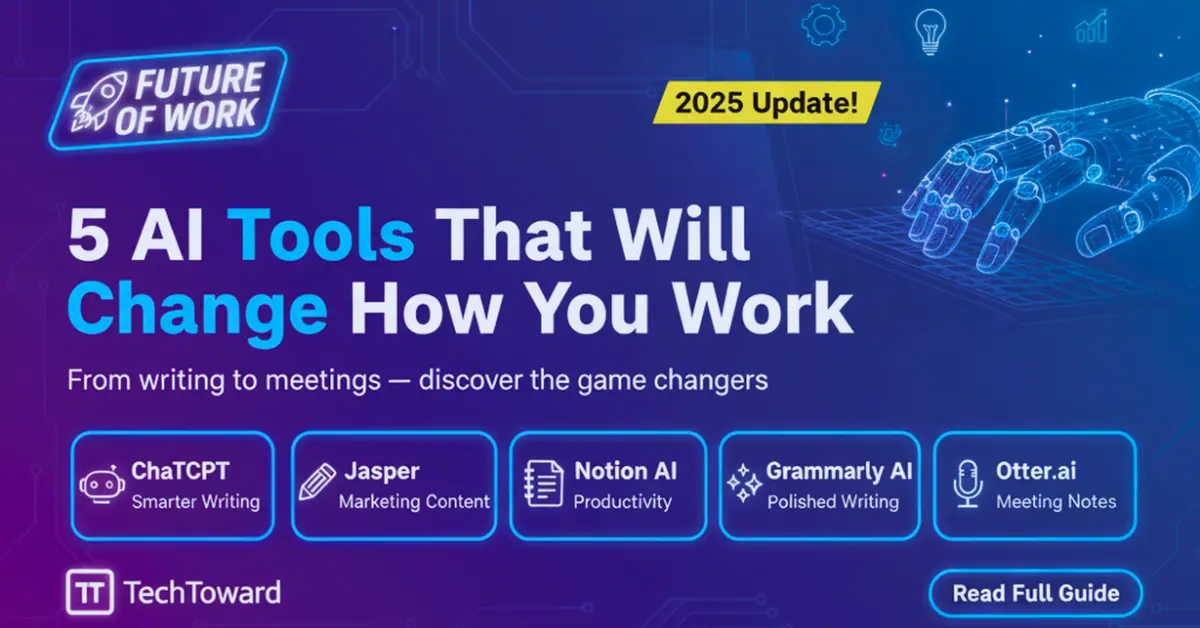Choosing the right AI tools can feel overwhelming, but with just a few well-selected ones—ChatGPT, Notion AI, Grammarly, Jasper AI, and Otter.ai—you can automate repetitive tasks, speed up creative work, and reclaim hours each week in a simple, effective way.
The modern workplace is evolving fast, and AI-powered productivity tools are leading the way. Whether you’re a freelancer, manager, creative, or corporate professional, these tools can take care of the time-consuming, tedious parts of your work, letting you focus on what matters most.
Below, I’ll walk you through 5 tools that are already reshaping how people work — including real use cases, strengths, limitations, and how to get started.
Why AI Tools Matter Today
Before we dig into the tools, here’s why they’re not just “nice to have,” but becoming essential:
-
Time Savings. The average knowledge worker spends ~28% of their day on emails and ~19% gathering information. AI tools can dramatically reduce those hours.
-
Quality & Consistency. Mistakes get caught. Style gets polished. Output becomes more professional.
-
Ease of Use. No coding needed—these tools use natural language interfaces.
-
Cost Efficiency. Many tools have free or affordable tiers — cheaper than hiring more staff.
1. ChatGPT: Your All-Purpose Writing & Research AI
What It Does:
ChatGPT is a conversational language model by OpenAI. You can ask it to draft emails, brainstorm ideas, write blog posts, explain complex topics, debug code, translate text, and much more.
Why It Stands Out:
Instead of returning a list of links (like a search engine), ChatGPT generates contextual responses in natural conversation. You can refine results by asking follow-up questions.
Real Use Case:
Emma, a marketing lead, uses ChatGPT to jam out first drafts of email campaigns. What once took 45 minutes now takes 10. She fine-tunes the tone and adds brand polish, not starting from blank.
Tips to Get More from ChatGPT:
-
Be specific: “Write a 150-word email launching our new feature to existing users, highlighting time savings.”
-
Give context: background, audience, tone.
-
Iterate: ask for revised versions.
-
Always fact-check critical content.
Limitations:
It has a knowledge cutoff (often 2024 for many versions), and occasionally hallucinates plausible-sounding but incorrect facts. Use it as a smart assistant, not a final authority.
2. Notion AI: Smarter Workspace + Content Assistant
What It Does:
Notion AI brings AI directly into your workspace—where your docs, notes, tasks, and databases already live. It helps with drafting, summarizing, translating, extracting tasks, brainstorming, and more.
Why It’s Unique:
Because it’s built into Notion’s structure, AI suggestions are context-aware — smarter suggestions based on your workspace and content. Unlike standalone tools, you don’t have to switch apps.
Real Use Case:
Marcus, a project manager, highlights messy meeting notes and asks Notion AI to “extract action items with names, due dates.” Instead of spending 20 minutes doing this manually, he has clean, structured tasks ready instantly.
Best Practices:
-
Start with summaries.
-
Standardize templates and ask AI to reformat.
-
Use AI to auto-generate drafts, then edit.
-
Extract insights: themes, sentiment, actionables.
Pricing:
Notion offers an AI add-on (around $10/mo per user) on top of its base subscription.
3. Grammarly: Next-Level Writing Help
What It Does:
Beyond grammar and spelling, Grammarly analyzes tone, clarity, style, and engagement. It’s more than a spell-checker — it’s a writing coach. Read More: Wikipedia
Why It Matters:
Clear, persuasive communication is essential in every role. Grammarly helps catch subtle errors, maintain consistent tone, and polish messages, documents, and content.
Real Use Case:
Priya, in sales, realized her emails too often sounded weak or apologetic. Grammarly flagged these issues, and by adopting its suggested edits, her response rates rose ~23%.
How to Use It Well:
-
Set your audience and intent (formal, casual, persuasive).
-
Review tone insights (are you sounding uncertain?).
-
Learn from suggestions instead of blindly accepting them.
-
Use the browser extension to get help everywhere (Gmail, Docs, LinkedIn, etc.).
Pricing:
-
Free: Basic grammar & spelling
-
Premium: ~$12–30/month (tone, clarity, word choice)
-
Business: Adds team style guides & analytics
4. Jasper AI: Content Creation for Marketers
What It Does:
Jasper (formerly Jarvis) focuses on marketing content: blog posts, ad copy, product descriptions, social media, landing pages. It includes templates for 50+ use cases.
Why It’s Strong:
While ChatGPT is general-purpose, Jasper’s strength lies in brand consistency and marketing content workflows.
Real Use Case:
David, a content consultant, uses Jasper to produce draft blog posts in 15 minutes instead of 2 hours. His time is spent refining, fact-checking, and giving it human flavor — tasks AI can’t replicate.
Tips for Best Results:
-
Train it on your brand voice (provide sample content).
-
Use templates (e.g. “Facebook Ad,” “Product Description”).
-
Give detailed briefs.
-
Edit strategically — add your unique insights and tone.
Pricing:
-
Creator plan: ~$39/month
-
Teams / Custom: More, depending on scale
5. Otter.ai: Meeting Transcription & Smart Notes
What It Does:
Otter turns speech into text in real time. It transcribes conversations, attributes speakers, summarizes key points, and extracts action items. It integrates with Zoom, Google Meet, Teams.
Why It’s Valuable:
Stop spending time frantically taking notes during meetings. Focus on the discussion. Let Otter handle the record-keeping.
Real Use Case:
Jennifer, an executive assistant, doesn’t attend every meeting. Otter records and transcribes, then she reviews the summary in 5 minutes and sends a polished version to stakeholders. She gained ~15 hours/week back.
Effective Use Tips:
-
Integrate with calendar so Otter auto-joins meetings.
-
Scan summaries first, then deep dive transcripts.
-
Encourage speakers to identify themselves early.
-
Use the search function to reference past meetings quickly.
Pricing:
-
Free: ~600 mins / month
-
Pro: ~$10/month (6,000 mins, better summaries)
-
Business/Enterprise: Advanced features & admin controls
Which Tools Fit You Best?
Here’s a comparison to help you choose:
| Tool | Best For | Use Case | Monthly Cost (approx.) |
|---|---|---|---|
| ChatGPT | General-purpose work | Writing, research, ideation | Free / ~$20 |
| Notion AI | Project & knowledge work | Workspace organization & drafting | ~$10 |
| Grammarly | All writers / communicators | Email, docs, tone & clarity | Free / ~$12–30 |
| Jasper AI | Marketing teams | Blog posts, ad copy, landing pages | ~$39+ |
| Otter.ai | Teams & meetings | Transcriptions & summaries | Free / ~$10+ |
Combos that work well:
-
Solo / Solopreneur: ChatGPT + Grammarly = a full writing suite.
-
Small teams / management: Notion AI + Otter.ai = structure + meeting intelligence.
-
Content agencies / marketers: Jasper + ChatGPT + Grammarly = scale + polish.
Getting Started: Your First Week with AI
To integrate these tools effectively, use this 7-day plan:
Days 1–2: Explore and Onboard
-
Sign up for 2–3 tools that address your biggest pain points
-
Walk through onboarding / tutorials
-
Experiment casually
Days 3–4: Automate One Task
-
Pick a daily, repetitive task
-
Try completing it using an AI tool
-
Compare time/quality vs your manual process
Days 5–7: Build Habits
-
Schedule specific windows to use AI for work (e.g. “draft with ChatGPT at 9am”)
-
Share results with colleagues — this encourages adoption
-
Iterate your process as you learn
Avoid these early pitfalls:
-
Over-reliance — always review AI output
-
Vague prompts — the more specific, the better
-
Trying too many tools at once — start small
-
Ignoring privacy — read data policies before feeding sensitive info
The Future of AI at Work
This is just the beginning. The next wave includes:
-
Multimodal AI — tools handling text, image, audio, video together
-
Adaptive AI — personalized to your style & workflows
-
Deeper integration — AI baked into every app you use
-
More democratization — powerful AI at lower cost for everyone
Professionals who treat AI as a partner — not a threat — will thrive. These tools give you scale, speed, and precision. You bring strategy, creativity, judgment, and empathy.
FAQ: AI Tools for Work
Q: Are these AI tools hard to learn?
A: No — they’re designed for non-technical users. Most become comfortable in a few hours of hands-on use.
Q: Will AI replace my job?
A: No. AI handles repetitive work. Humans bring insight, judgment, and creativity — qualities machines can’t replicate well.
Q: Are these tools secure?
A: Reputable tools offer strong security, but always read the privacy terms before uploading sensitive data.
Q: Do I need to pay?
A: All five offer free tiers or trials: ChatGPT, Grammarly, Notion AI, Otter.ai — you can test before buying.
Q: What if AI gives wrong info?
A: Always fact-check important outputs. Use AI to speed things up, not as a final source.
Q: Can these tools work together?
A: Yes! Use ChatGPT for ideation, Jasper for drafts, Grammarly for polish, Notion AI for structure, Otter for meetings — each tool plays its strength.
Conclusion & Next Step
These 5 AI tools — ChatGPT, Notion AI, Grammarly, Jasper AI, and Otter.ai — are not sci-fi. They’re practical, available now, and powerful. You don’t need to change your whole workflow overnight. Start with one tool that solves your biggest pain point, master it, then layer in the others.
Your next move: Choose one tool, signup (free trial is fine), and use it for one task this week. Experience firsthand how AI reduces friction, speeds work, and elevates your output.
The future of work is here — don’t wait to be productive with it.


